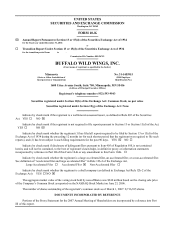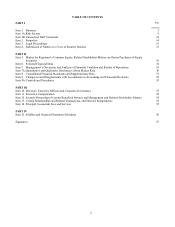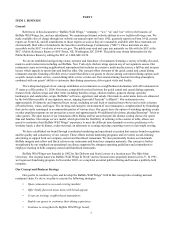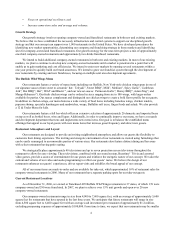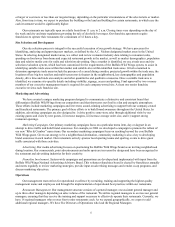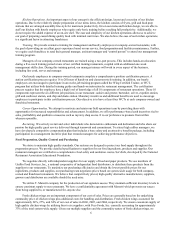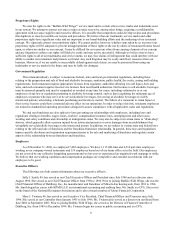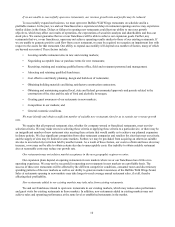Buffalo Wild Wings 2006 Annual Report Download - page 6
Download and view the complete annual report
Please find page 6 of the 2006 Buffalo Wild Wings annual report below. You can navigate through the pages in the report by either clicking on the pages listed below, or by using the keyword search tool below to find specific information within the annual report. Kitchen Operations. An important aspect of our concept is the efficient design, layout and execution of our kitchen
operations. Due to the relatively simple preparation of our menu items, the kitchen consists of fryers, grill and food prep
stations that are arranged assembly-line style for maximum productivity. Given our menu and kitchen design, we are able to
staff our kitchen with hourly employees who require only basic training before reaching full productivity. Additionally, we
do not require the added expense of an on-site chef. The ease and simplicity of our kitchen operations allows us to achieve
our goal of preparing casual dining quality food with minimal wait times. We also believe the ease of our kitchen operations
a significant factor in attracting franchisees. is
Training. We provide extensive training for management and hourly employees at company-owned restaurants, with
the goal of providing an excellent guest experience based on our service, food preparation and facilities maintenance. Further,
we require each franchisee to send their general manager, assistant manager and “control person” to attend our management
training program.
Managers of our company-owned restaurants are trained using a two-part process. This includes hands-on education
during a five-week training period at one of our certified training restaurants, coupled with an additional one-week
management skills class. During this training period, our manager trainees will work in every aspect of the business,
including line cook, server and manager.
Our hourly employees in company-owned restaurants complete a comprehensive position certification process. A
station certification process requires 16 to 20 hours of hands-on and classroom-style training. In addition, our hourly
employees are encouraged to participate in an on-the-job training program called the Wing Certified Trainer, or WCT,
program that utilizes both detailed training guides and hands-on instruction by restaurant management. The certification
process requires that the employee have a high level of knowledge of all 10 components of restaurant operations. These 10
components represent the six different job positions in our restaurant: cashier and greeter, bartender, server, expedite station,
grill and southwest station, and chip and shake station. Monetary incentives and additional benefits are used to encourage
employees to participate in this certification process. Our objective is to have at least four WCTs at each company-owned and
franchised restaurant.
Career Opportunities. We attempt to motivate and retain our field operations team by providing them with
opportunities for increased responsibilities and advancement. In addition, we offer performance-based cash incentives tied to
sales, profitability and qualitative measures such as mystery shop scores. It is our preference to promote from within
henever possible. w
Recruiting. We actively recruit and select individuals who demonstrate enthusiasm and dedication and who share our
passion for high quality guest service delivered through teamwork and commitment. To attract high caliber managers, we
have developed a competitive compensation plan that includes a base salary and an attractive benefits package, including
participation in a management incentive plan that rewards managers for achieving performance objectives.
ood Preparation, Quality Control and Purchasing F
We strive to maintain high quality standards. Our systems are designed to protect our food supply throughout the
preparation process. We provide detailed specifications to suppliers for our food ingredients, products and supplies. Our
restaurant managers are certified in a comprehensive food safety and sanitation course, ServSafe, developed by the National
Restaurant Association Educational Foundation.
We negotiate directly with independent suppliers for our supply of food and paper products. We use members of
UniPro Food Services, Inc., a national cooperative of independent food distributors, to distribute these products from the
suppliers to our restaurants. To maximize our purchasing efficiencies and obtain the lowest possible prices for our
ingredients, products and supplies, our purchasing team negotiates prices based on system-wide usage for both company-
owned and franchised restaurants. We believe that competitively priced, high quality alternative manufacturers, suppliers,
rowers and distributors are available should the need arise. g
We utilize T. Marzetti company for the production of our signature sauces. They maintain sufficient inventory levels to
ensure consistent supply to our restaurants. We have a confidentiality agreement with Marzetti which prevents our sauces
om being supplied to, or manufactured for, anyone else. fr
Fresh chicken wings are an important component of our cost of sales. Prices are generally based on the underlying
commodity price of chicken wings plus additional costs for handling and distribution. Fresh chicken wings accounted for
approximately 24%, 27%, and 34% of our cost of sales in 2006, 2005, and 2004, respectively. We ensure consistent supply of
high quality chicken wings by utilizing four to six suppliers, with Peco Foods, Inc. currently accounting for approximately
33% of the total system-wide supply. Given our multiple suppliers and the commodity nature of fresh chicken wings, we
6

